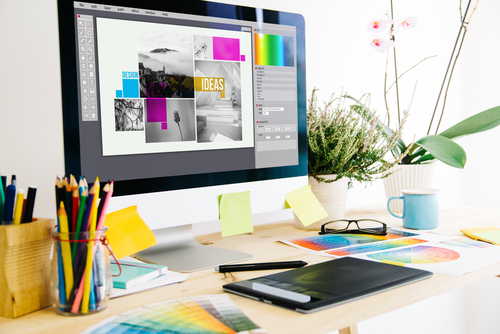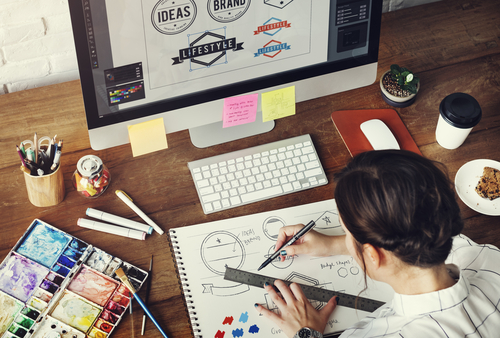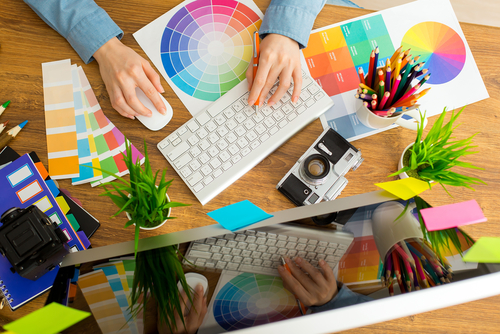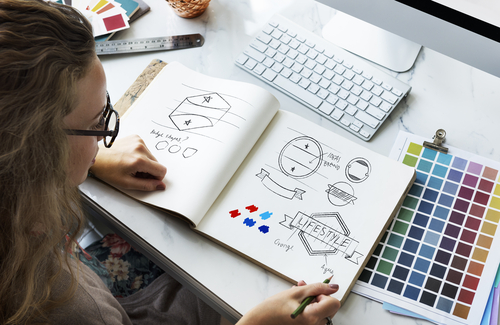Do I Need To Create a Website for My Graphic Design Work?
If you are pursuing a career in graphic design, you may have wondered whether developing a website for graphic design work is a good idea. Below you will find an answer to this question.
Should You Create A Website For Your Graphic Design Work?
If you have decided to become a graphic designer, it is definitely a good idea for you to create a website that showcases the work that you have done so far. This is the case for several reasons, one of which is that it gives prospective clients an opportunity to see your talent and understand what type of work you do. Additionally, creating a website for your graphic design work enables you to begin building the type of strong online presence which will help earn you an authoritative, positive reputation on the internet. Yet another benefit of developing a website that displays your work is that it helps build your brand. Specifically, viewers who examine your work via website will be exposed to the distinct and differentiating elements that make your business and services unique from those offered by your competitors. All of these factors are important, and each one of them will help you increase your conversion rates and build a loyal client base.
Things To Include
Once you recognize the great value in creating a website that will showcase your graphic design work, you may be ready to get started. If so, consider including the following elements in your website:
1. Great Content
As many internet marketing experts continue pointing out, content is king in the world of online advertising. This is the case for many reasons, including the fact that content is an excellent and often primary source through which internet users can gain more information about your business and the services you offer. Since this is the case, you should make a point to create high quality content. Several factors go into the production of great content, and one of them is your ability to make the text “scannable” by including elements such as bullets, headers, and numbered lists.
2. Functionality
If you want your website to function as a medium through which you can attract new clients, it needs to be as functional as possible. This means that viewers should be able to easily navigate from one page to another and they shouldn’t be distracted by large ads, pop-up images, and any other element that detracts from the ability to read your content and learn more about your graphic design company. The more functional your website is, the more likely visitors are to return to it.
3. SEO Optimization
In order to ensure that your website becomes a medium capable of garnering new business for you, it needs to attain high ranking in the search engine results pages of major engines such as Google, Bing, and Yahoo. To make this happen, you should include proven SEO (search engine optimization) strategies such as link building, keyword analysis, anchor text optimization, and SMO (social media optimization).
Key Concepts to Effective Graphic Design
Aside from showcasing prowess in the above areas of great content, functionality, and SEO optimization technique, there are 10 finer points in good graphic design work that should also be properly finessed in order to make the best impressions. Show that you know how to create a graphic design with the best of the best by following these guidelines.
Font
Whether it be a research paper for school or a work presentation, font can make a significant difference in the effect that any visual presentation makes. This is just as true in the world of graphic design work today. But, how do you know what kind of fonts to use and when?
The answer to this can be tricky, but a major rule of thumb is to maintain easy readability. Font that is too extravagant in style or too small can be a sure turn-off to the reader. In general, no more than three fonts should ever be used in a single graphic design presentation, as the use of more than three can potentially make the piece feel astray. If more than one font is used, it’s typically best to use others that provide some contrast to the first. For example, Roboto and many of its subsets can often work well together just as Serif and Sans-Serif do.
Contrast
Contrast in the use of multiple fonts is important. So too is the use of contrast in many other components of a graphic design presentation. In particular, contrast goes to the heart of drawing attention to certain elements and creating separation among them. Color, spatial organization, fonts, pictures, and borders are just a few of the elements in graphic design that can be used in order to create just the right amount of contrast between elements.
With fonts, contrast can be created using different styles as well as bold and italic features. With color, contrast can really stand out when complementary colors or highly opposing colors are strategically used. Likewise, borders and other elements of contrasting separation can really become effective with the use of color contrast or even the use of fading.
Alignment
Alignment tools are typically included in virtually all design programs. This for a very good reason. Alignment is a powerful design element that truly defines and organizes a design. As such, the use of improper alignment can create a very haphazard, chaotic, and disorganized appearance.
Alignment is also a component of graphic design that often goes unnoticed unless there is a problem. It helps the flow of a design and directs the viewer’s attention where it should be. The best graphic designers know this trick all too well and use it to their full advantage in creating the most effective presentations.
Color
Color is another very key component to making an effective graphic design that is attractive and effective. Improper use of color, in fact, can be such a powerful deterrent that the whole message being conveyed can be lost before the viewer even realizes it. This is because of the power of color in the human psyche.
As touched on above, complementing colors and opposing color schemes can be highly effective to a good graphic design when used at the right place and time. Aside from this tip, the use of warm colors can be very inviting, warm, and soothing to the viewer’s eye. On the other hand, cooler colors can convey coolness, serenity, and even sadness at times. As a solid graphic designer, it’s a good idea to understand each color’s uses and individual effects on the range of human emotions.
Audience
Next, a firm awareness of the intended audience you intend to notify of your message is key to understanding all other choices made in an effective graphic design presentation. For example, a graphic design format aimed at professional companies is likely best served by avoiding whimsical or loud color and other design choices. Likewise, a graphic design aimed at children and less-serious subjects is probably better to not appear as firm, strong, or over commanding in nature.
Space
Much like and related to the topic of alignment, proper use of space is incredibly important to viewer palatability. Improper use of space, may even go unnoticed on a conscious level, but unconsciously, it can create awkward features in a graphic design that draw away from its overall efficacy and goals. In this respect, it’s good to be aware of the power of negative space and its use in highlighting the most important elements of a design.
White space also has its place in creating proper distinction between design elements. However, “white space” does not have to be white. It can be composed of any color that creates the right spatial distinction for the design at hand.
Repetition and Consistency
Repetition and consistency can be very important in graphic design presentations. This is especially true if there is an element of branding taking place in the design. “Branding” in this context is the use of specific imagery to distinguish a particular brand or company.
An example of proper use of repetition and consistency in a design would be the use of consistent page headers in a multi-page publication. It’s also good to note, however, that there are times where consistency and repetition can become over-used and draw away from the intended effect of a design. This is often more a concern in intentionally whimsical or outlandish types of presentations.
Simplicity
Simplicity is a particular design element that incorporates many of the other elements listed here such as spacing, alignment, and even font and color choices. At its core, simplicity often works in a design because it is void of frivolous distractions. This, in turn, can lead to a greater effect of the design feeling more accomplished, trustworthy, straightforward, or reliable.
Hierarchy
Next, graphic designers are also very wise to consider the element of hierarchy in much of their graphic design work. Hierarchy in graphic design is the establishment of the importance of various presented components through the use of visual cues. One way that this is accomplished is through large or small fonts. Positioning of a graphic component can also clearly establish its hierarchical importance in the overall design. Similarly, space and color can also be great tools for establishing the hierarchy of the components in a design.
Distortion
Finally, the proper use or avoidance of distortion can also make or break a graphic design project. In graphic design, distortion is defined as the use of an element, such as a picture, that has been stretched or otherwise distorted so that it is clearly not in its original form. In most cases, distortion is a significant drawback to a graphic design. However, in a few cases, such as in those that are intentionally whimsical or wanting to show distortion as part of the key message, this element can become an effective one.
Associations of Interest
Growing to become an accomplished graphic designer and knowing how to create a graphic design appropriate for virtually any purpose can take plenty of experience and research. To that end, it can be invaluable to be aware of some of the top resources of graphic design know-how in the broader industry today. The following organizations represent several recommended resource venues with which any graphic designer can learn more or even reach out for some valuable guidance when needed.
American Institute of Graphic Arts
The American Institute of Graphic Arts, also known as AIGA across the industry, is the largest association of designers of all kinds. While most of this group’s perks do require membership to access, those with an active membership can benefit greatly via a vast array of educational resources, publications, design job listing resources, professional advocacy benefits, and more. As of this writing, membership starts at $50 for one year.
Society of Illustrators
The Society of Illustrators was first formed in 1901 to advocate for and represent the professional world of illustrators. As graphic design and other areas of illustration came about, the society has come to encapsulate representation of those areas as well. This organization offers many resources as well as an annual exhibition that is highly regarded across the professional world.
Society for Experiential Graphic Design
One more excellent resource for the wide world of graphic designers is that of the Society for Experiential Graphic Design. This organization features many members from over 35 countries and offers many learning opportunities in the form of numerous annual conferences, educational and research links, job search help, and more. Membership is also an option that offers plenty of additional perks.
Conclusion
As you begin developing a website to display your graphic design work, remember that prospective clients will often view it as an example of the type of creative and organizational capabilities you would employ if hired to complete a project for them. With this in mind, remember that creating an excellent, informative website that effectively demonstrates your talent and aptitude is important. Now that you have some basic information regarding how to create a website for graphic design work, you can begin the process of developing and maintaining your own unique, brand-building site.
Related Resources:
- Top 10 Online Graphic Design Degree Programs
- 5 Tips to Design Your Graphic Design Website
- 5 Ways to Get Traffic to Your Graphic Design Website
- 30 Great Graphic Design Scholarships for Graphic & Website Design Majors
- Top 13 Best Affordable Graphic Design Degree Programs
- Top 15 Online Associate in Graphic Design
- Top 15 Online Bachelor’s in Graphic Design
- Top 8 Affordable Online Graphic Design Master’s Degrees



